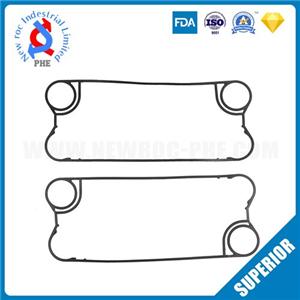ion dan kaedah pengiraan penukar haba plat
The heat exchanger is a new type of high-efficiency heat exchanger made up of a series of metal heat exchanger plates with a certain corrugated shape. For various manufacturers and users, the calculation methods and formulas for the selection of plate heat exchangers are the most important, because the designed plate heat exchanger is very critical for the production and use of the operation.
The plate type or corrugated shape of the heat exchanger is determined according to the actual needs of the actual working conditions. In the case of large flow and small pressure drop, the plate type with low resistance should be selected, otherwise, the plate type with large resistance should be selected. According to the fluid pressure and temperature, it is decided to choose a detachable plate heat exchanger or a brazed plate heat exchanger. When judging the plate type, it is not advisable to choose heat exchanger plates with too small single plate area to avoid too many heat exchanger plates, the flow velocity between the heat exchanger plates is too small, and the heat transfer coefficient is too low. Heat exchangers should pay more attention to this question.
Plate heat exchanger process and selection of plate heat exchanger runners
The process refers to a group of parallel flow channels in the plate heat exchanger in the same direction of movement of a medium, and the flow channel refers to the medium movement channel formed by two adjacent plates in the plate heat exchanger. Generally, several flow channels are connected in parallel or in series to form different combinations of cold and hot medium channels.
The process combination method should be calculated based on heat exchange and fluid resistance, and determined when the technical requirements are met. Try to make the convective heat transfer coefficients in the cold and hot water channels equal or close, and then get the best heat transfer effect. Because the convective heat transfer coefficient on both sides of the heat transfer surface is equal or close, the heat transfer coefficient obtains a larger value. Although the flow velocity between the plates of the plate heat exchanger is not equal, the uniform flow velocity is still used when calculating the heat exchange and fluid resistance. Since the reception of the
Calculation method and formula
(1) Find the heat load QQ=G. ρ. CP. Δt
(2) Find the inlet and outlet temperature of the cold and hot fluid t2=t1 Q /G. ρ. CP
(3) Flow rate of cold and hot fluid G = Q / ρ. CP. (t2-t1
(4) Find the uniform temperature difference ΔtmΔtm=(T1-t2)-(T2-t1)/In(T1-t2)/(T2-t1) or Δtm=(T1-t2) (T2-t1)/2
(5) Choosing board type If all board types are selected, the effect analysis will be carried out.
(6) According to the K value planning, calculate the plate number planning Nmin, NmaxNmin = Q / Kmax. Δtm. F P. βNmax = Q / Kmin. Δtm. F P. β




